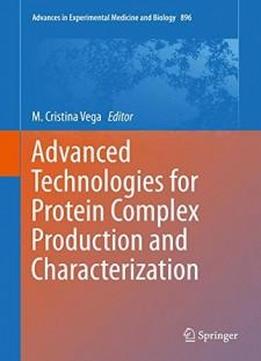
Advanced Technologies For Protein Complex Production And Characterization (advances In Experimental Medicine And Biology)
by M. Cristina Vega /
2016 / English / PDF
16.3 MB Download
This book presents advanced expression technologies for the
production of protein complexes. Since complexes lie at the heart
of modern biology, the expression, purification, and
characterization of large amounts of high-quality protein
complexes is crucial for the fields of biomedicine,
biotechnology, and structural biology. From co-expression in
This book presents advanced expression technologies for the
production of protein complexes. Since complexes lie at the heart
of modern biology, the expression, purification, and
characterization of large amounts of high-quality protein
complexes is crucial for the fields of biomedicine,
biotechnology, and structural biology. From co-expression inE. coli
E. coli, yeast, mammalian and insect cells to complex
reconstitution from individual subunits, this book offers useful
insights and guidance for successful protein expressionists.
, yeast, mammalian and insect cells to complex
reconstitution from individual subunits, this book offers useful
insights and guidance for successful protein expressionists.
Across several sections readers will discover existing
opportunities for the production of protein complexes in
bacterial systems (including membrane proteins and cell-free
co-expression), methylotrophic and non-methylotrophic yeasts,
protozoa (
Across several sections readers will discover existing
opportunities for the production of protein complexes in
bacterial systems (including membrane proteins and cell-free
co-expression), methylotrophic and non-methylotrophic yeasts,
protozoa (Leishmania terantolae
Leishmania terantolae and
andDictyostelium
discoideum
Dictyostelium
discoideum), baculovirus-infected insect cells, mammalian
cells, plants and algae. Complex reconstitution from individually
purified subunits or subcomplexes is discussed as a complementary
strategy. A last section introduces briefly some of the
biophysical and structural characterization techniques for
macromolecular complexes using state-of-the-art solution
scattering and nuclear magnetic resonance.
), baculovirus-infected insect cells, mammalian
cells, plants and algae. Complex reconstitution from individually
purified subunits or subcomplexes is discussed as a complementary
strategy. A last section introduces briefly some of the
biophysical and structural characterization techniques for
macromolecular complexes using state-of-the-art solution
scattering and nuclear magnetic resonance.
This work is a guided tour over some of the most powerful and
successful protein expression technologies, with a focus on
co-expression and high-throughput applications. It is addressed
to everyone interested in the production and characterization of
macromolecular complexes, from university students who want an
accessible description of the major co-expression systems to
researchers in biomedicine and the life sciences seeking for an
up-to-date survey of available technologies.
This work is a guided tour over some of the most powerful and
successful protein expression technologies, with a focus on
co-expression and high-throughput applications. It is addressed
to everyone interested in the production and characterization of
macromolecular complexes, from university students who want an
accessible description of the major co-expression systems to
researchers in biomedicine and the life sciences seeking for an
up-to-date survey of available technologies.











